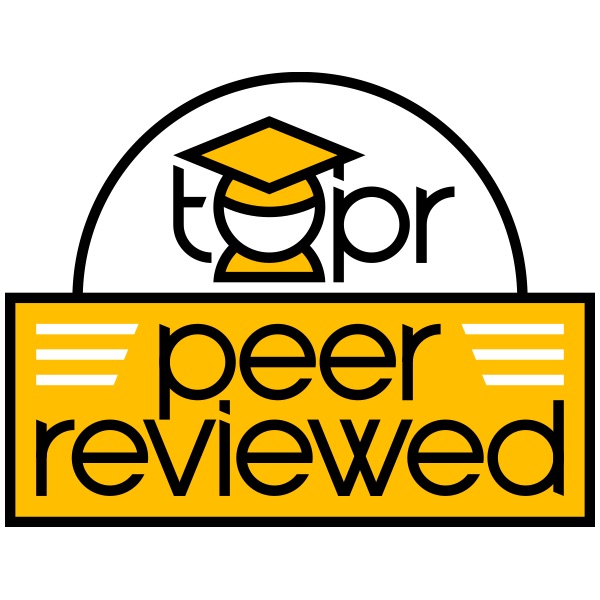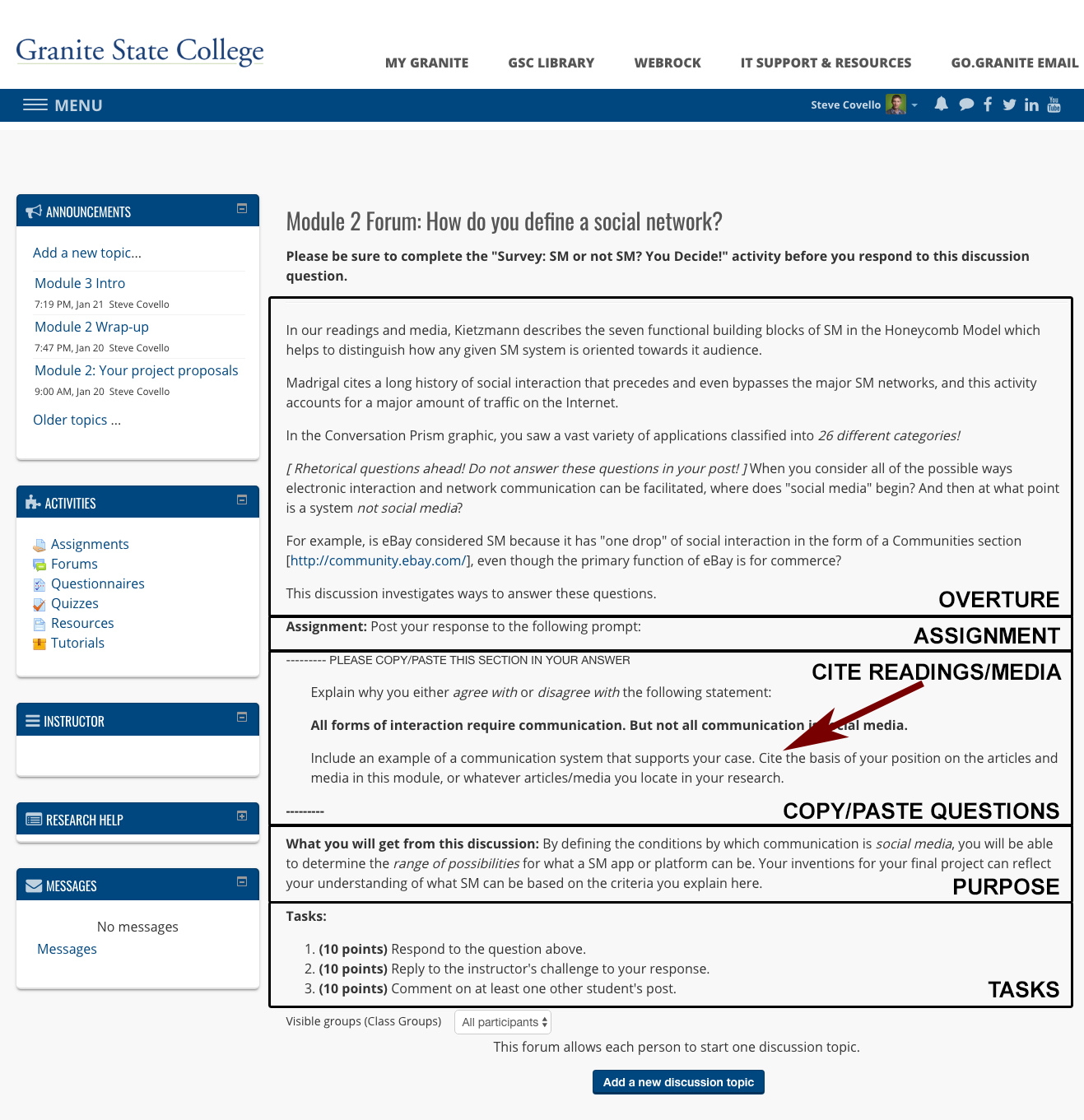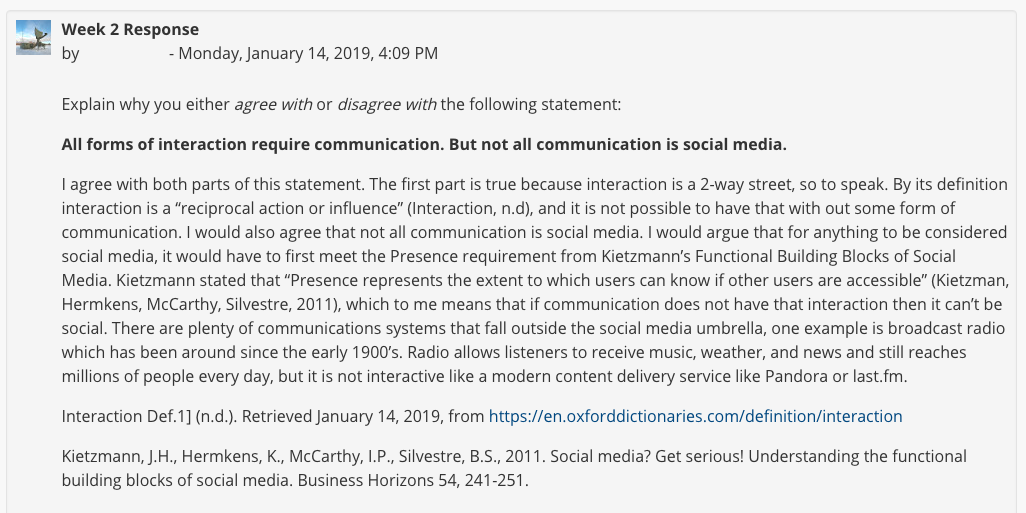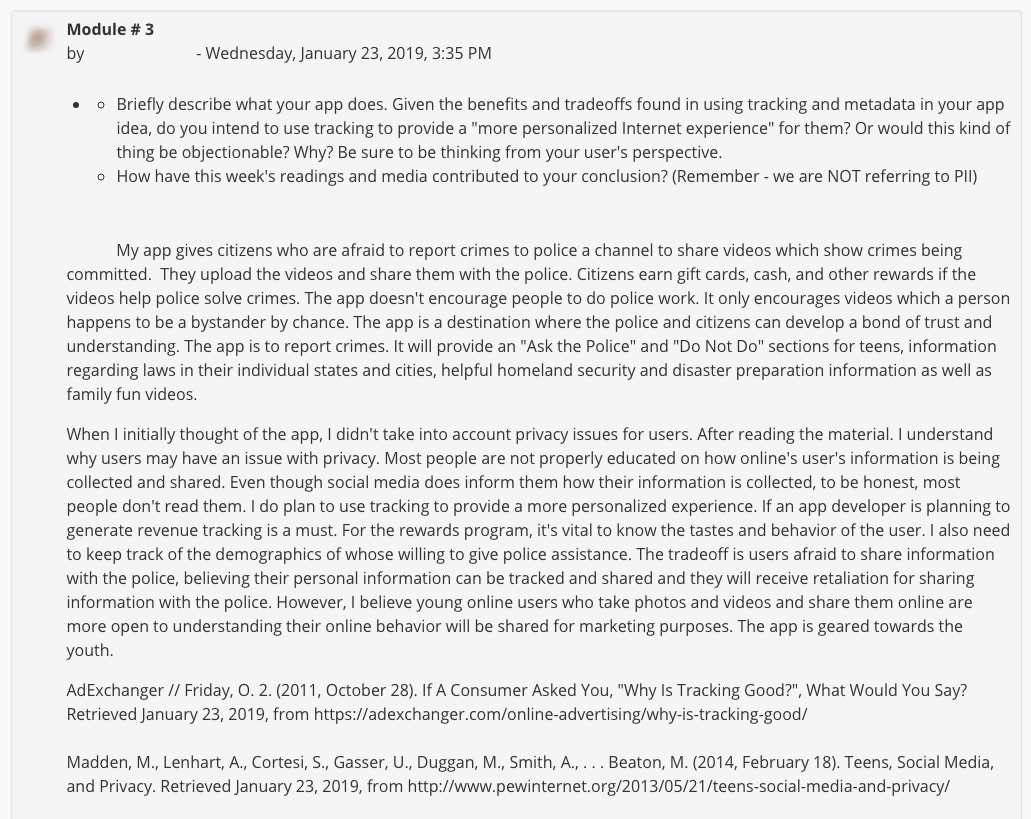
Asynchronous online teaching is fundamentally a communications challenge. What is gained in online learning by extending access through a Web-based LMS is offset by the loss of the immediacy and semantic richness of in-person instructional communication (Daft, R. L., & Lengel, R. H., 1986; Moore, M., 1993). In online discussion forums, students, in isolation, are often put in the position of producing a response based entirely on their own interpretation of the instructor’s text-based assignment prompt. The semantic leanness of text-based media poses a number of potential pitfalls for students to feel uncertain about what to do in an online discussion, or they may improvise a response based on what they believe the assignment instructions mean.
Evidence of these communication challenges have been observed in incidental student behavior in online discussion forums as follows:
- Students mistakenly responded to the rhetorical questions in the overture instead of the actual discussion questions. This behavior was interpreted to mean that the prompt lacked visual cues for students to distinguish between rhetorical statements and actual discussion questions.
- Students responded to an improvised assumption of what they thought the assigned discussion question was supposed to be rather than what it actually was. This behavior was interpreted to mean that the prompt lacked a distinction of what the actual assignment was.
- Students responded to only the first question in a prompt that contained multiple contingent questions. This behavior was interpreted to mean that, in the process of intellectual engagement in the subject matter, students lost focus of the original set of questions.
- Students responded to discussion questions based on how they felt instead of constructing a position based on authoritative resources, with citation. This behavior was interpreted to be caused by naive or improvised understandings of online academic discourse.
- Students’ summative writing in their signature project papers did not draw from their own analysis work produced in the discussion forums. This was interpreted to mean that students did not realize that there was a coherent relationship between the outcome of an academic discussion and the application of that outcome as a component of producing a summative artifact.
Goal Statements for Productive Online Discussions
In addressing these concerns, the following hypotheses were developed about learners in an online discussion forum setting, each followed by a goal statement to inform design strategies to overcome these issues:
- Given the infinite cognitive and experiential diversity of individuals, there are many ways for a set of written instructions to be interpreted (Foreman Wernet, 2003). Goal: Reduce ambiguity.
- Online students, who are untethered to specific dates/times for classroom attendance, are engaged in their online course work in multiple intervals over several days. Fragmented engagement with the instructor, classmates, instructional media, and actual instructional activities can cause loss in a sense of instructional focus. Goal: Reinforce coherence.
- Students may have had little or no prior experience with academic online discussions as an instructional experience. They also may not know the character of an instructor’s discussion style in advance of engagement. These factors lead to potential problems in students meeting the instructor’s expectations. Goal: Reduce uncertainty and promote academic discourse.
- If the prompt does not actually identify what the assignment is, students may not know what the assignment is. Goal: Increase explicitness.
- If the prompt does not explain why a topic is being discussed, students may not know why they’re discussing it or how to apply what they have concluded from it. Goal: Reinforce purpose.
Link to scholarly artifact(s)
Instructor: Steve Covello
Course: COMM601: Trends in Digital & Social Media (fully online upper-level undergraduate course in the Communications degree program)
An approach was developed to improve student performance by designing a discussion forum prompt structure containing the following elements:
- Overture: Stimulate recall of readings/media, add context. Addresses fragmentation and coherence.
- Statement of the assignment: State the actual assignment in a visually unambiguous format. Addresses ambiguity, coherence, and uncertainty.
- Discussion questions: Post the actual questions to be answered and then direct students to copy/paste them into their response. Addresses uncertainty and explicitness.
- References to readings/media/research: Include a variant of the statement, “How have the readings and media influenced your position?”. Addresses purpose and academic discourse.
- Purpose: State how the discussion is relevant to the subject matter, area of inquiry, or how it is connected to other topics/assignments/knowledge/skills. Addresses purpose.
- Tasks/Assessment: State the tasks that comprise completion of the entire activity and the basis upon which they will be assessed. Addresses task uncertainty.
Figure 1 (below) demonstrates how the elements of the proposed forum prompt design appears in an assignment.

In the example below (Figure 2), a student responds to a discussion forum prompt containing a single question. Note that the student has copy/pasted the discussion question and has cited the basis of their position which was drawn from one of the assigned readings (Keitzmann).

In the example below (Figure 3), a student responds to a different discussion forum prompt that contains multiple questions. The student has responded to both questions and has provided citation.

In the prior examples, an attempt is made to impose both a narrative and visual structure upon the prompt text so that learners can differentiate between rhetorical, instructive, and directive content. In a way, this mimics the more analogue semantics found in a classroom setting: recognizing cues in the lecturer’s speech, tone, sequencing, timing, and body language to discern when and how to respond in classroom interaction.
Effectiveness
Among the proposed visual and structural techniques are two elements described in greater detail below:
- The copy/paste technique: Direct students to copy the questions indicated in
the assignment section and paste them into their own responses. - The “What will you get out of this…” technique : Include a section of the
prompt that explains how the outcome of the discussion would be useful in the instructional context.
From informal polling at the conclusion of the course over multiple terms, students have consistently indicated that these two techniques were helpful at some level. 84% of respondents (n=72) agreed that the copy/paste technique at least helped some, and 89% of respondents (n=37) agreed that the “what will you get out of this technique” at least helped some.
Conclusion
The preceding techniques address the perceived causes of inconsistent student performance in online asynchronous discussion forums. Some of the causes of the problems are endemic to the semantic thinness of an asynchronous, text-based communication environment while others appear to be more related to patterns of visual organization and the explicitness of the assignment directions.
While these techniques have not been validated in formal research, it is evident from students’ reactions that efforts to improve the quality of communication in online instruction are well-received. It is also worth mentioning that the techniques proposed above do not, on their own, assure improved student performance. Writing a good discussion forum prompt cannot be successful in isolation of other larger pedagogical factors in online course design. Consider the following design elements that operate in the online learning environment in support of students’ needs:
- At a course level: Provide clear examples of how students are expected to respond in discussion forum assignments. This includes a rubric that describes the criteria for assessing discussion participation and examples of forum responses that correspond with each level of assessment.
- At a module level: Instructional goals should be stated as objectives so that the purpose of the discussion can be easily connected to achieving what is expected in the instructional interval.
- In presenting instructional media : Assigned readings and media should not be presented simply as a bullet list. Include thematic statements on what to look for in each item so that students can read/watch/interact with a purpose, e.g. for reference in a discussion or in written reflection. Strive for fostering lean in engagement rather than passive lean back engagement.
- Afterwards: Provide feedback on student performance so that they will be able to identify how they may improve their work to meet expectations. An example would be, “You earned 28/30 points in this week’s discussion. Good work, though you can earn the maximum amount if you include examples to support your position. Otherwise your statements will be considered hearsay.”
Link to scholarly references
Daft, R. L., & Lengel, R. H. (1986). Organizational information requirements, media richness and structural design. Management Science , 32 (5), 554-571.
Dervin, B. (2003). Sense-Making’s Journey from Metatheory to Methodology to Method: An Example using Information Seeking and Use as Research Focus (Original work published 1999). In B. Dervin and L. Foreman- Wernet with E. Lauterbach (Eds.). Sense-Making methodology reader: Selected writings of Brenda Dervin (Chapter 8, pp. 133-163). Cresskill, NJ: Hampton Press.
Fleming, M., & Levie, W. H. (1993). Instructional message design; principles from the behavioral and cognitive sciences (Ed2 ). New Jersey: Educational Technology Publications, Inc.
Foreman-Wernet, L. (2003). Rethinking Communication: Introducing the Sense-Making Methodology. In B. Dervin and L. Foreman-Wernet with E. Lauterbach (Eds.). Sense-Making methodology reader: Selected writings of Brenda Dervin (Chapter 1, pp. 3-16). Cresskill, NJ: Hampton Press.
Moore, M. G. (1993). Theory of transactional distance. In D. Keegan, (Ed.), Theoretical principles of distance education. New York: Routledge.
Citation
Covello, S. (2019). Create structured discussion prompt to reduce ambiguity, reinforce purpose, and promote discourse. In A. deNoyelles, A. Albrecht, S. Bauer, & S. Wyatt (Eds.), Teaching Online Pedagogical Repository. Orlando, FL: University of Central Florida Center for Distributed Learning. https://topr.online.ucf.edu/create-structured-discussion-prompt-to-reduce-ambiguity-reinforce-purpose-and-promote-discourse/.